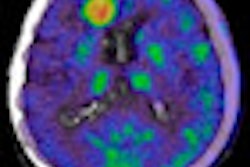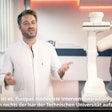
The combined use of MRI and PET appears to be superior to and more cost-effective than the use of MRI alone in surgical therapy planning for high-grade gliomas, German researchers found in a study published online on 14 March in the Journal of Nuclear Medicine.
Lead study author Dr. Alexander Heinzel, from the department of nuclear medicine at Heinrich-Heine University in Düsseldorf, calculated a cost for MRI and PET between 2,948 euros ($3,832 U.S.) and 4,105 euros ($5,336 U.S.) per additional year of patient survival compared to results with MRI alone. The difference in cost depends in part on the severity of the cancer.
MRI is considered the gold standard in imaging for high-grade gliomas, he noted. However, previous studies have concluded MRI can be limited in distinguishing tumor tissue from edematous, necrotic, or fibrotic tissue, which can lead to discrepancies in tumor size and signal abnormalities in MRI. In one study of patients with high- and low-grade gliomas, MRI achieved sensitivity of more than 90% for the detection of tumor tissue, but specificity lagged at 53%.
Previous studies have also found that PET imaging with radiolabeled amino acids is superior to CT and MRI in gauging the size and extension of high-grade gliomas. In addition, the combination of MRI and amino acid PET imaging can more accurately detect tumor tissue and unaffected brain tissue.
To determine the financial implications of MRI and PET compared to MRI, the researchers devised an incremental cost-effectiveness ratio (ICER). The calculation took the cost of MRI and PET minus the cost of MRI and divided it by the number of life-years gained by MRI and PET minus life-years gained by MRI.
In Germany, however, PET imaging is not reimbursed with amino acid tracers. As recently as January 2011, Germany's Institute for Quality and Efficiency in Health Care determined that "no robust conclusions are possible" on the advantages or disadvantages of using PET to detect recurrences of malignant gliomas.
The report reviewed 12 studies on PET and concluded that the results differed so substantially between studies that no general answer could be provided. In addition, not a single study on PET/CT was found.
Calculating costs
To overcome this obstacle, Heinzel and colleagues used statutory health insurance rates to calculate costs. In addition, outcomes were defined by the mean survival years of glioma patients. Based on previously published data, a patient with a complete resection had a mean survival of 32.5 months, while a patient with an incomplete resection had a mean survival of 17.6 months.
The researchers then considered two scenarios for the study: a baseline study and a situation where a patient had greater disease severity. In both models, Heinzel and colleagues assumed a "willingness-to-pay threshold" of 30,000 euros ($39,000 U.S.) for either imaging option per year of survival.
Cost calculations showed that PET and MRI resulted in an incremental cost-effectiveness ratio of 2,948 euros ($3,832 U.S.) and 4,105 euros ($5,336 U.S.) per additional year of patient survival, compared with MRI alone.
In the researchers' baseline model, MRI and PET achieved superior results in 61% of the samples compared to MRI alone, given a willingness to pay of 30,000 euros per year of survival. MRI and PET were inferior to MRI alone in 35% of the cases, regardless of the willingness-to-pay threshold, while MRI and PET were considered inferior in the remaining 4% with regard to willingness to pay.
Disease severity
In the case of greater disease severity, MRI and PET were superior in 60% of the samples compared to MRI alone, factoring in a willingness-to-pay threshold. In addition, MRI and PET were considered inferior in 35% of the cases, independently of a threshold, and inferior in 5% of the results with a willingness to pay, compared to MRI alone, respectively.
Based on the results, the researchers concluded MRI with PET "appears to be superior to the use of MRI alone" in the surgical therapy planning of high-grade gliomas. Compared with MRI alone, the ICER of PET and MRI was less than 5,000 euros ($6,587 U.S.) per life-year gained, even if the admissible-charge-rate scenario was assumed, indicating that PET in addition to MRI may be a cost-effective option.
Heinzel and colleagues added, however, that because the "model is based on limited empiric evidence, additional studies of high methodologic quality addressing survival time and quality of life are needed to confirm the results."



















